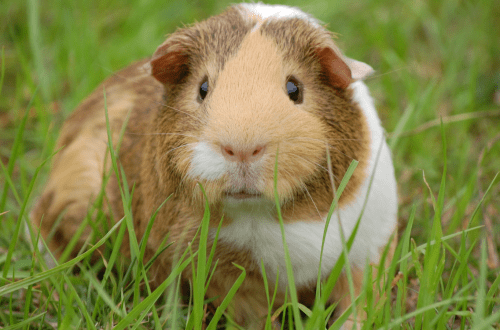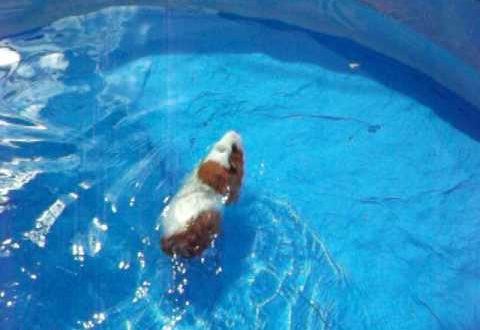
Antibiotics and drugs for guinea pigs: use and dosage
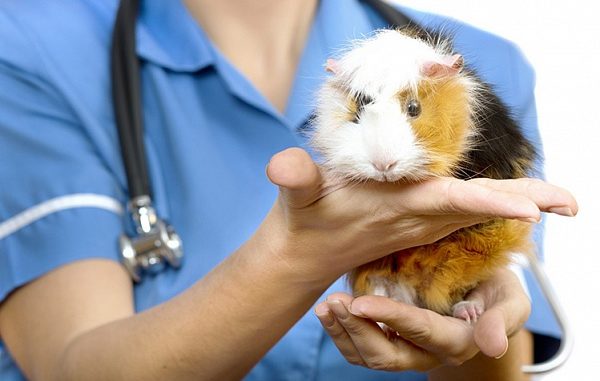
Guinea pigs have inherited from their wild relatives good health and a fairly long lifespan for rodents. However, in case of violation of the conditions of feeding and maintenance, communication with infected relatives, cute pets are often exposed to various infectious and non-contagious diseases. The body of guinea pigs is characterized by a high metabolism, so all pathological processes develop rapidly. In the absence of competent therapeutic measures, serious complications quickly arise, and the animal dies.
IMPORTANT!!! Self-treatment of guinea pigs at home with antibiotics and toxic antiparasitic drugs without determining the sensitivity of pathogenic microflora to drugs, violation of dosages, frequency of administration and duration of use of the drug is fraught with the development of irreversible degenerative processes and the death of a pet. A veterinary specialist, preferably an experienced rodentologist, should find out the cause of the disease, make a diagnosis and prescribe specialized treatment according to the instructions for a particular drug.
Contents
- How to calculate the dose of a drug for a guinea pig
- How to properly administer medication to a guinea pig
- How to give a guinea pig a powder, suspension or tablet
- How to inject guinea pigs
- What are the most commonly prescribed medications for guinea pigs?
How to calculate the dose of a drug for a guinea pig
To independently calculate a single dose of a drug for a fluffy animal, you need to know the concentration and name of the active substance of a particular drug, its dosage for guinea pigs, the body weight of a sick pet, and be able to perform simple arithmetic operations studied in elementary school.
A veterinarian should prescribe a certain type of drug, its dose and duration for a specific pathology, most drugs can be used in different dosages, which depend on the severity of the disease, general condition, weight and age of the small patient.

The dosages of a certain medicinal substance for guinea pigs in veterinary reference books are prescribed in mg / kg, which means the amount of administration of mg of a particular drug per 1 kilogram of pet weight. Veterinary and human medicines used to treat small rodents come in the form of solutions, powders, tablets, capsules and suspensions.
The instruction of a certain drug has information about the concentration of the active substance in each ml of solution, one capsule or tablet, according to these data, a single dose of the drug for a particular animal is calculated. If the percentage value of the concentration is indicated on the ampoule or vial with the drug solution, it must be multiplied by 10 to convert to mg / kg.
An example of calculating the common antibiotic Batril 2,5% for a guinea pig weighing 800 g
We find the name of the active substance Enrofloxacin and its concentration in 1 ml of solution – 2,5%. We translate the percentage value into mg / kg by multiplying this number by 10: 2,5 * 10 u25d 1 mg / kg. This numerical value of the concentration can be found in the instructions for the drug, which means that 25 ml of Baytril solution contains XNUMX mg of Enrofloxacin.
The Veterinary Handbook contains Enrofloxacin dosing information for guinea pigs. This value is 10-20 mg / kg, depending on the diagnosis, the severity of the pathology and the condition of the sick animal. Let’s say a veterinarian has given a pet a common dosage of 10mg/kg. To calculate a single dose of the active substance for a specific animal weighing 800 g, we multiply the dosage by body weight: 10 * 0,8 = 8 mg.
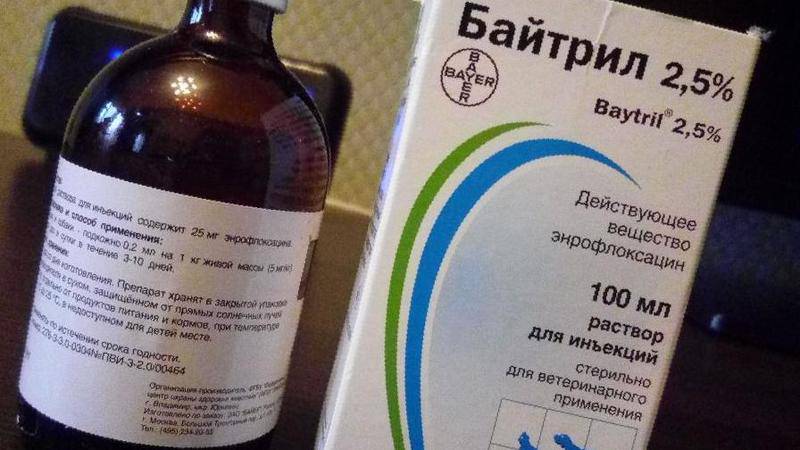
To calculate the required amount of 2,5% Baytril solution for one injection, it is necessary to divide the dose of the active substance for a certain animal by its concentration: 8/25=0,32 ml. This means that 0,3 ml of injection solution must be drawn into the insulin syringe for one injection.
Similarly, a single dose of all dry and liquid forms of drugs for guinea pigs is calculated. When self-administering drugs to domestic rodents, it is necessary to strictly observe:
- dosage;
- frequency rate of subcutaneous, intramuscular or oral administration;
- the duration of taking the drug as prescribed by the veterinarian.
All this will help to avoid intoxication of your beloved pet or the transfer of pathology into a chronic form.
How to properly administer medication to a guinea pig
Depending on the type of pathology and the form of release of the drug, the veterinarian prescribes drugs to the pet in the form of:
- powder;
- tablets;
- injection solutions;
- suspensions
Transportation and visiting a veterinary clinic is an additional stress for the body of a sick pet, so often the owners of guinea pigs give injections and give prescribed medications on their own.
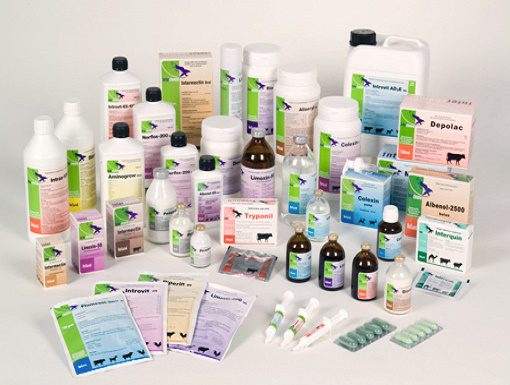
How to give a guinea pig a powder, suspension or tablet
Medicines in the form of suspensions most often have a pleasant taste. This greatly simplifies their feeding to guinea pigs. The amount of suspension prescribed by the specialist:
- Draw in a syringe without a needle.
- They lead into the oral cavity behind the incisors.
- Gently press on the piston, controlling the swallowing of the drug by the animal.
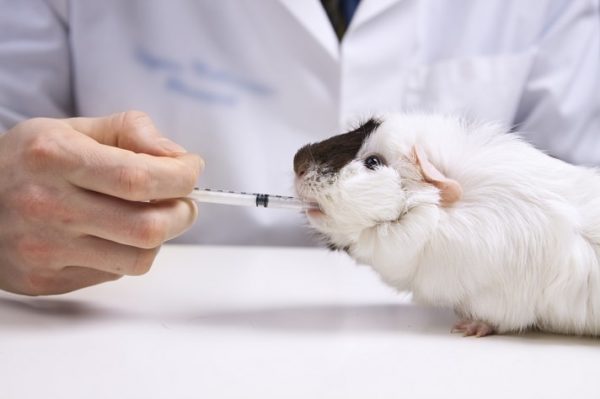
Liquid drugs with an unpleasant taste or dry drugs diluted in boiled water are administered in a similar way with additional fixation of the animal in the abdomen and back so that the pet cannot escape when the drug is administered orally.
Powders should be given to guinea pigs mixed with pasty feed. Food should be crushed to this state and given in a syringe without a needle. If the powder has a neutral taste, you can sprinkle it on your favorite treats. The pleasant tasting tablet can be crushed and mixed with food. Bitter or water-soluble tablets must be given directly into the animal’s mouth. The drug must be pushed to the cheek teeth and ensure that the pig swallows it. You can push the medicine with a hemostatic tourniquet that does not injure the guinea pig’s mouth.
How to inject guinea pigs
Injectable preparations are prescribed to guinea pigs more often than dry forms. They have a less toxic effect on the gastrointestinal tract. Liquid medicines are administered subcutaneously or intramuscularly. In order to make an injection subcutaneously, you must:
- With two fingers grab the skin at the withers.
- Insert a syringe with a needle into the formed skin fold parallel to the back of the animal.
- Carefully inject the solution.
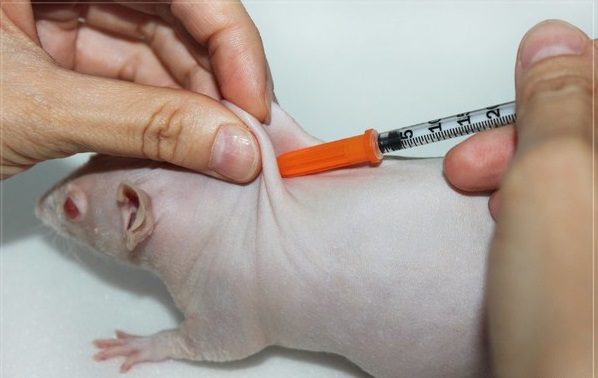
An intramuscular injection of the drug is made into the thigh of a small patient. To do this, it is advisable to wrap the guinea pig with a towel, leaving the back of the animal free. This is necessary so that the fluffy animal cannot escape and scratch the owner. The owner of a pet must be prepared for a painful reaction of the animal during the introduction of the needle, so as not to let the patient out of surprise. The syringe with the drug must be injected at an angle into the thigh muscle. To pierce the sufficiently thick skin of the animal, you need to make some efforts and gently inject the medicine.
What are the most commonly prescribed medications for guinea pigs?
Depending on the cause and nature of the pathology, guinea pigs are prescribed antimicrobial, antiparasitic, vitamin, immunostimulating, painkillers, hormonal, anti-inflammatory drugs and probiotics.
Antibiotics for guinea pigs
Antibacterial agents are often prescribed to guinea pigs in the treatment of:
- catarrhal infectious diseases;
- pathology of the genitourinary and respiratory systems;
- abscesses and pododermatitis.
Antibiotics inhibit the vital activity of not only pathogenic, but also healthy microflora. The simplest microorganisms living in the gastrointestinal tract break down coarse plant food to a digestible state. Often, against the background of thoughtless or prolonged uncontrolled use of antibiotics, lethargy and diarrhea occur in guinea pigs, which leads to death of the pet.
Antibiotics are given to guinea pigs after bacterial culture has been performed. The procedure is necessary to determine the sensitivity of the pathogen to antimicrobial drugs. In case of side effects or no improvement within the first three days after the start of the drug, the veterinarian changes the drug.
Often, guinea pigs develop enterotoxemia due to increased sensitivity to the antibiotic.
Pathology manifests itself:
- diarrhea;
- lethargy;
- refusal of food;
- decrease in body temperature.
This often causes the sudden death of a small animal.
The following antibiotics are toxic to guinea pigs: penicillin, ampicillin, gentamicin, bacitracin, lincomycin, clindamycin, vancomycin, erythromycin, tylosin, tetracycline, and chlortetracycline.
Most often, the following antimicrobial agents are used to treat fluffy pets.
Baytril (analogues of Enroflon, Enroxil, Enrofloxacin)
Used for guinea pigs at a dosage of 10 mg/kg 2 times a day for:
- catarrhal diseases;
- the pododermas;
- diseases of the respiratory and respiratory system;
- diseases of the digestive tract.
It is a broad-spectrum antibacterial agent that negatively affects stunting in young animals. It is recommended to inject Baytril for 7-10 days, depending on the condition of the small animal and the neglect of the disease. In order to avoid the development of necrosis at the injection site, it is recommended to dilute the antibiotic with saline.
Sumamed (analogues of Azithromycin, Azivok, Azitrox, Sumazid, Azitral, Sumamox, Chemomycin)
Guinea pigs are prescribed at a dosage of 30 mg / kg 2 times a day for pathologies of the respiratory and genitourinary systems. Sumamed is a broad-spectrum antibiotic that negatively affects stunting in young animals.
Vibramycin (analogues of Monoclin, Unidox Solutab, Doxycycline, Bassado)
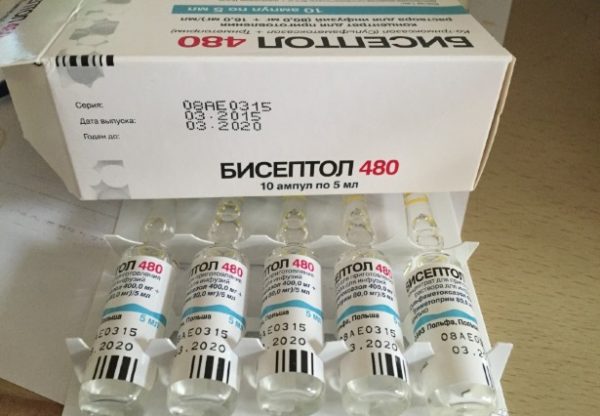
Guinea pigs are prescribed at a dosage of 10-20 mg / kg 2 times a day for infectious diseases and secondary infections, it is a broad-spectrum antibiotic, it is not recommended for use in the treatment of young animals, pregnant and lactating females.
Biseptol
This is a combined broad-spectrum bactericidal drug. It is given to guinea pigs at a dosage of 30 mg/kg twice daily for:
- ear inflammation;
- genitourinary and respiratory systems;
- diseases of the gastrointestinal tract.
It does not affect the growth of young animals. It is very convenient to give biseptol to a guinea pig in the form of a suspension for children, which has a pleasant taste.
Together with the course of antibiotics, the veterinarian must prescribe probiotics. These drugs contain live cultures of beneficial bacteria and replenish healthy microflora after the toxic effects of antibiotics. With oral administration of antibiotics, it is necessary to withstand at least 2 hours before drinking probiotics. Probiotics are usually diluted in warm boiled water. If the drug is administered as an injection, then a pause between drug administrations is not needed.
Probiotics
Guinea pigs are prescribed the following probiotics to restore the microflora of the gastrointestinal tract:
- Vetom 1.1 – a veterinary drug for the prevention and treatment of gastrointestinal diseases and increasing the body’s natural resistance, guinea pigs are prescribed 3 times a day at a dosage of 50 mg / kg;
- Lineks – a probiotic intended for the treatment and prevention of dysbacteriosis is prescribed to guinea pigs 3 times a day at a dosage of 50 mg / kg;
- Bifidumbacterin – a medicine intended for the treatment and prevention of dysbacteriosis is prescribed to guinea pigs 3 times a day at a dosage of 50 mg / kg.
Linex and Bifidumbacterin are purchased at a regular pharmacy, all probiotics must be diluted immediately before use, the solutions are drunk to the pet from a syringe without a needle.
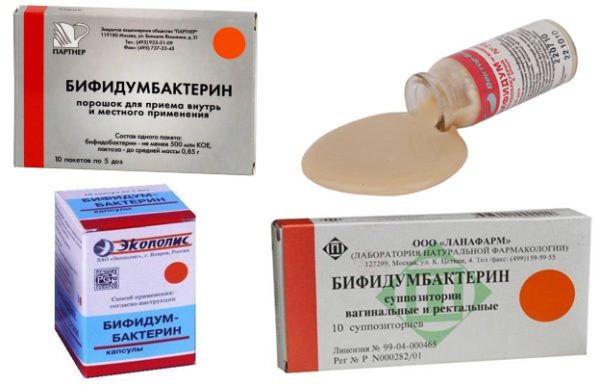
Antiparasitics for guinea pigs
Antiparasitic drugs are prescribed to guinea pigs when protozoa, nematodes and ectoparasites are parasitized in their bodies. If protozoa are found in the feces of a domestic rodent, specialists prescribe a course of injectable antibiotics to the sick animal: Baytril at a dosage of 10-20 mg/kg or Metronidazole at a dosage of 15-30 mg/kg 2 times a day.
When an animal is affected by nematodes or parasitic insects, guinea pigs are prescribed the following antiparasitic veterinary drugs:
- Stronghold – an antiparasitic agent based on selamectin, used for guinea pigs at a dosage of 6 mg / kg, a liquid drug is applied externally to the withers of the animal;
- Novemek – an antiparasitic injectable drug based on ivermectin, for guinea pigs is used at a dosage of 0,2 mg / kg;
- Otodectin – antiparasitic injectable drug based on ivermectin. For guinea pigs, use at a dosage of 0,2 mg / kg according to the instructions of a specialist. The drug is considered less toxic than Novomek and Stronghold.
Preparations for increasing the immunity of guinea pigs
Pathologies significantly undermine the immunity of fluffy animals, therefore, to restore the body’s resistance, along with the main treatment, guinea pigs are prescribed vitamin and immunostimulating agents:
- Gamavit – a combined immunomodulatory drug that helps strengthen the immune system and improve metabolism. Gamavit for guinea pigs is prescribed at a dosage of 1 ml / kg. Subcutaneous and oral administration of a drug solution is allowed;
- Catosal – a vitamin remedy used to improve metabolism and stimulate metabolic processes. It is prescribed at a dosage of 0,5 ml / kg;
- Faithfully – an immunostimulating drug aimed at increasing the body’s resistance. Used at a dosage of 0,1 ml/kg.
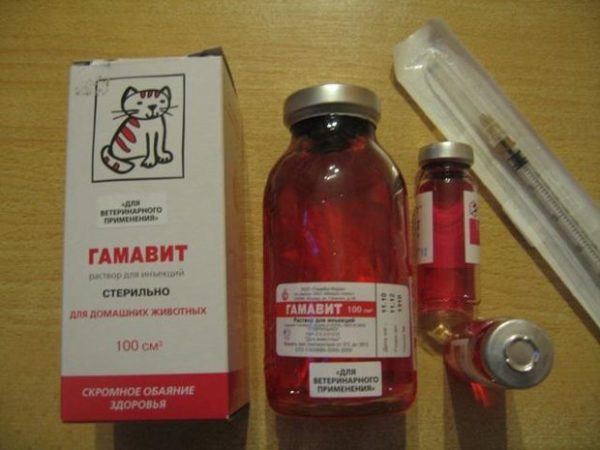
First aid supplies for guinea pigs
Quite often, situations arise with guinea pigs that require urgent assistance before the arrival of a veterinarian, for this purpose, the owner of fluffy pets must have the following drugs in the first aid kit:
- Traumatic – anti-shock, hemostatic and anti-inflammatory drug, used for guinea pigs with injuries, bleeding, inflammatory processes at a dosage of 0,1 ml / kg;
- Cerucal – antiemetic, prescribed at a dosage of 1 mg / kg;
- Oxytocin – a hormonal drug that stimulates uterine contractions is used in guinea pigs with pathological childbirth at a dosage of 0,01 ml / kg.
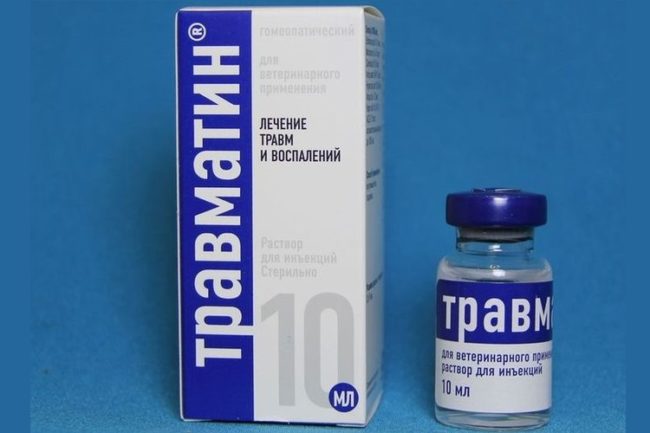
Owners of guinea pigs are advised to contact specialists when the first symptoms of the disease appear. Self-diagnosis of pathology and the appointment of drugs is fraught with the death of a beloved pet.
The use and dosage of drugs for guinea pigs
3.2 (63.33%) 6 votes



